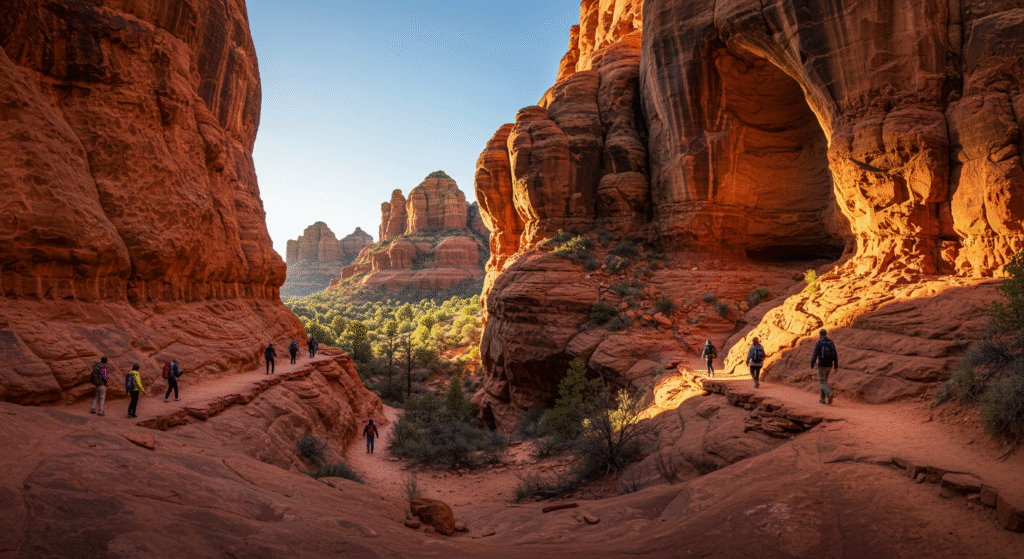Why This Trail Stands Out
Boynton Canyon Trail in Sedona, Arizona, is a special hike. It has red rock views, a hidden Subway Cave, and a famous energy vortex. This guide gives you all the details to plan your hike. I’m Warren Driscoll, a travel writer with over seven years of experience. Since 2018, I’ve stayed in private villas in Ibiza, Saint-Tropez, and chalets in the French Alps. I hiked this trail in 2023 and share my firsthand knowledge here.
Trail Basics
Boynton Canyon Trail is a 6.6-mile out-and-back hike in Sedona’s Red Rock-Secret Mountain Wilderness. It’s moderately hard with an 800-foot elevation gain. The hike takes 3 to 6 hours, depending on detours to the Subway Cave or Boynton Vista Trail. You’ll see red cliffs, green forests, and desert plants like cypress and manzanita. A Red Rock Pass ($5/day) or America the Beautiful Pass is needed for parking.
Getting to the Trailhead
The trailhead is in west Sedona, off Dry Creek Road near Enchantment Resort. From Flagstaff, drive 27 miles south on US 89A to Sedona. Turn right on Dry Creek Road, then follow signs to Boynton Canyon Road. The parking lot fits about 25 cars and fills fast. Arrive before 7 AM to get a spot. You can park along Boynton Pass Road if the lot is full. A vault toilet is at the trailhead.
What Makes This Hike Unique
This trail mixes stunning nature with cultural history. You’ll see red rock cliffs, shaded pine forests, and wildlife like mule deer or canyon wrens. The Subway Cave, a keyhole-shaped rock formation, offers amazing views. The Boynton Canyon Vortex, near Kachina Woman rock, is known for spiritual energy. The trail is sacred to Indigenous groups like the Yavapai-Apache, adding deep meaning.
Step-by-Step Hiking Guide
Starting the Trail
The hike starts at the northwest end of the parking lot, across from the bathroom. It begins on Deadman’s Pass Trail for a short distance. Follow signs for Boynton Canyon Trail. The path is wide and sandy at first, passing Enchantment Resort. Look at the red cliffs ahead, not the resort buildings.
First Half Mile
At 0.3 miles, a sign points right to Boynton Vista Trail. This 0.4-mile round-trip detour leads to Kachina Woman, a rock spire and vortex site. The vista gives wide views of Sedona’s red rocks. It’s great for sunrise or sunset and takes about 10 minutes. If you skip it, stay left on the main trail.
Miles 0.5 to 2.0
The trail gets narrower and rockier. You’ll walk through shaded areas with ponderosa pines and manzanita bushes. At about 1.5 miles, look for Sinagua ruins in caves on the east canyon wall. Use binoculars to see them clearly. These ancient homes are fragile, so don’t touch or climb them.
Finding the Subway Cave
The Subway Cave is between miles 2.0 and 2.4. Look for a large alligator juniper tree on the left. Its branch stretches across the trail. Opposite this tree, a spur trail goes right to the cave. Some hikers mark it with a stone arrow, but it’s not official.
- Spur Trail Details: The path is narrow with roots and rocks. Follow the most worn trail for 0.3 miles. It’s easy to miss, so watch closely.
- Entering the Cave: You’ll reach a steep rock chute. Scramble up carefully or take a gentler path to the left. The cave is a keyhole-shaped space with great canyon views.
- Time Needed: Plan 30–60 minutes to explore and take photos. The cave can be busy, so be patient.
Beyond the Cave
Return to the main trail after the cave. It climbs gently through pine and oak forests. At 3.0 miles, you enter a box canyon with steep cliffs. The trail gets rockier and steeper. At 3.3 miles, it ends at a viewpoint below Bear Mountain. Enjoy dramatic views of the canyon walls before turning back.
Returning to the Trailhead
Follow the same path back. If you skipped Boynton Vista Trail, consider it on your return. The total hike, including the cave, is about 7.1 miles and takes 4 to 6 hours.
Exploring the Subway Cave
The Subway Cave is a rock formation, not a deep cave. Its keyhole shape frames Boynton Canyon beautifully. Nearby Sinagua ruins show ancient life. These are sacred, so view them from a distance.
Tips for the Cave
- Safety: The scramble to the cave is steep. Wear sturdy shoes with good grip. Avoid if you have trouble moving.
- Respect: Don’t touch ruins or leave trash. Follow Leave No Trace rules.
- Photos: Early morning or late afternoon light is best for pictures.
The Boynton Canyon Vortex
The vortex is on Boynton Vista Trail, near Kachina Woman, an 80-foot rock spire. It’s one of Sedona’s four main vortexes, known for balanced masculine and feminine energy. Some feel calm or energized here; others feel nothing. Sit quietly by Kachina Woman to reflect and enjoy the views.
How to Visit the Vortex
- Take the 0.4-mile Boynton Vista Trail detour.
- Find Kachina Woman at the end of the trail.
- Spend 10–20 minutes in silence to feel the energy.
Best Times to Hike
By Season
- Spring (March–May): Mild weather, wildflowers, but very crowded.
- Fall (September–November): Colorful leaves, cool temperatures, busy.
- Winter (December–February): Cooler, less crowded, possible light snow.
- Summer (June–August): Very hot, hike early to avoid heat.
By Time of Day
- Start at sunrise (6–7 AM) for parking and cool weather.
- Late afternoon is good for cave photos but busier.
How to Prepare
What to Pack
- Water: Bring 2 liters per person.
- Snacks: Pack energy bars or fruit.
- Gear: Wear hiking shoes, a hat, and sunscreen. Use a backpack with a water bladder.
- Navigation: Download the AllTrails app for offline maps. GPS works without service.
- Pass: Get a Red Rock Pass or America the Beautiful Pass.
Safety Tips
- Check the weather for sudden changes.
- Stay on marked trails to avoid getting lost.
- Watch for rocks that can trip you.
- Don’t hike alone in summer heat.
Respecting the Land
Boynton Canyon is sacred to Native American tribes. The Subway Cave and ruins are archaeological sites. Follow these rules:
- Stay on trails to protect plants and soil.
- Don’t touch or take artifacts.
- Pack out all trash, even small bits.
- Keep noise low to respect hikers and wildlife.
Why This Trail Is Special
This trail blends adventure and peace. The shaded path is pleasant even in warm months. The Subway Cave adds excitement, and the vortex offers a spiritual touch. My 2023 hike showed me its beauty. The red rocks and quiet forests felt alive and powerful.
How It Compares to Other Hikes
- Devil’s Bridge: Shorter (4.2 miles), crowded, iconic arch.
- Cathedral Rock: Steep, short (1.2 miles), vortex site.
- Soldier’s Pass: Similar length (4.7 miles), has caves and pools.
- Birthing Cave: Short (2 miles), easier, less busy.
Boynton Canyon is longer but offers more variety. Its mix of scenery, history, and spirituality makes it stand out.
Photography Tips
- Subway Cave: Shoot during golden hour for soft light.
- Vortex: Capture Kachina Woman with red rocks behind.
- Gear: Use a wide-angle lens for the cave. A zoom lens helps for ruins.
- Respect: Don’t climb ruins or rocks for photos.
Nearby Places to Visit
- Fay Canyon Trail: 2.6 miles, easy, has an arch.
- Tlaquepaque Arts Village: Shops and galleries in Sedona.
- Doe Mountain Trail: 1.5 miles, great views, less crowded.
Final Notes
Boynton Canyon Trail is a top Sedona hike. Its red rocks, hidden cave, and vortex make it unforgettable. Plan ahead, start early, and respect the land. My years exploring luxury destinations taught me to value real experiences like this. Use this guide for a safe, meaningful hike.
Disclaimer
This article is for general information only. It shares one person’s hiking experience and tips about the Boynton Canyon Trail. It is not professional advice or a replacement for official park information. This is not a sponsored or paid article. No company or brand has paid to be included. All thoughts and opinions are my own, based on my personal hike in 2023. Always check the weather, trail rules, and your own health before hiking. Respect local laws, signs, and the land — especially sacred or protected areas.
Explore More
- Villa Elaine Paros: Fancy 4-Bedroom Villa with Infinity Pool & VIP Chef
- Vilamoura Portugal Villas: Exclusive 2025 Stays Near Golf, Marina & Beaches

Warren Driscoll writes about luxury travel. He has over seven years of experience. Since 2018, he has stayed in private villas in Ibiza and Saint-Tropez, and chalets in the French Alps. Warren’s stories have been shared by Indvidual Magazine. He writes honest reviews and gives helpful tips to help people plan great holidays. He also shares his own photos and real experiences to make his advice clear and useful.
